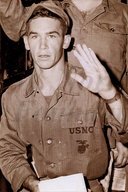
|

|
|
|
|
Charles was born in Texarkana, Texas as one of two children to Johnnie Lois Sherrer and Addie Lee Dodd Sherrer, a nurse. Johnnie was an electrician (who would later own Texas Electric in Texarkana) but worked as a carpenter making fifty cents an hour during the Depression. In those days, he recalls, wayfarers slept in "Hobo Jungle" in woods at the end of his street, and knocked on their door to ask for food. "It wasn't like they were bums," he recalls. "They were just guys that had lost their jobs and were out of work." As a teenager Charles worked in his dad's electrician shop as well as "icing" railroad cars with 100- and 200-pound blocks of ice for refrigeration. He also hunted and fished with his father. After graduating from high school in 1948 Charles entered Texarkana Junior College. Meanwhile, he enlisted in the U.S. Marine Corps, joining a reserve unit, and learning how to fire 155-millimeter howitzers. Called up during the Korean War, he left Texarkana on July 31, 1950 for Camp Pendleton in California. By then a sergeant, he did not go through boot camp. "I was schooled enough in my trade, in my MOS; I was needed more over there than I was in boot camp, so I went overseas," he recalls. He was in artillery fire control, 4th Battalion Headquarters Battery, 4th Battalion, 11th Marine Regiment. On August 12, 1950 in Oceanside, California, a navy chaplain married him and Dolores Rachel, whom he had known since the fourth grade. (They would have two children.) Charles sailed to Korea on August 15, 1950, and made the Battle of Inchon and its famous landing of U.S. forces on September 15. Charles landed on Wolmido Island, a smaller body of land on the "hook" of Inchon. "Scared as hell," he says of his first reaction to combat. After participating in the capture of Seoul, Charles' unit fought its way north to the Chosin Reservoir where they came into combat with Chinese forces. When several in artillery were needed in infantry, Charles was sent to Dog Company, 5th Marine Regiment, as a gunner of a 30-caliber machine gun. He participated in the famous winter retreat south from the Chosin Reservoir. He recalls it took "nine to ten days to get out of the trap". After re-supplying in Puson, he says, "they put us on a train to go back up north and start shooting again." Of his service in Korea, he fondly remembers the time he and others were pushing a jeep stuck in the road to discover that one of the soldiers helping them was General Matthew Ridgway. "That's when we said, `He's bound to be a good guy,'" he recalls. Charles left Korea aboard the USNS General W.M. Black on August 9 1951. Although he was discharged, Charles later re-enlisted in the Marines and rose to the rank of warrant officer. He served for more than 32 years and retired on April 1, 1981. Charles has worked for 18 years at Barksdale Air Force Base in the pharmacy refill section as a volunteer. He also belongs to a reunion organization, the Chosin Few Club. |


